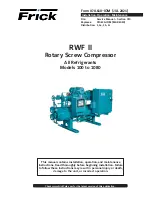
www.scheppach.com
22 | GB
f.
Keep cutting tools sharp and clean. Properly
maintained cutting tools with sharp cutting edg-
es are less likely to bind and are easier to control.
g.
Use the power tool, accessories and tool bits
etc. in accordance with these instructions,
taking into account the working conditions and the
work to be performed.
Use of the power tool for operations different from
those intended could result in a hazardous situa-
tion.
h.
Keep handles and grasping surfaces dry,
clean and free from oil and grease.
Slippery
handles and grasping surfaces do not allow for
safe handling and control of the tool in unexpected
situations.
Service
a.
Have your power tool serviced by a qualified
repair person using only identical replacement
parts.
This will ensure that the safety of the power tool
is maintained.
Safety instructions for compressors
m
Attention!
The following basic safety measures
must be observed when using this compressor for pro-
tection against electric shock, and the risk of injury and
fire.
Read and observe these instructions before using the
device.
Safe work
.
1. Take care of your tools
- Keep your compressor clean in order to work well
and safely.
- Follow the maintenance instructions.
- Check the connection cable of the power tool reg-
ularly and have it replaced by a recognised spe-
cialist when damaged.
- Check extension cables regularly and replace
them when damaged.
2. Pull the connector out of the socket
- When the power tool is not in use or prior to main-
tenance and when replacing tools such as saw
blades, bits, milling heads.
f.
Dress properly. Do not wear loose clothing or
jewellery. Keep hair, clothing and gloves away
from moving parts.
Loose clothes, jewellery or long hair can be caught
in moving parts.
Rubber gloves and anti-slip footwear are recom-
mended when working outdoors.
Tie long hair back in a hair net.
g.
If dust extraction and collection devices can
be mounted, make sure that they are connect-
ed and used properly.
Use of dust collection can
reduce dust-related hazards.
h.
Do not let familiarity gained from frequent use
of tools allow you to become complacent and
ignore tool safety principles.
A careless action can cause severe injury within a
fraction of a second.
Power tool use and care
a.
Do not overload the device.
Use the correct power tool for your application.
The correct power tool will do the job better and
safer at the rate for which it was designed.
b.
Do not use the power tool if the switch does
not turn it on and off.
Any power tool that can-
not be controlled with the switch is dangerous
and must be repaired.
c.
Disconnect the plug from the power source
and/or remove the battery pack, if detachable,
from the power tool before making any adjust-
ments, changing accessories, or storing pow-
er tools.
Such preventive safety measures reduce the risk
of starting the power tool accidentally.
d.
Store idle power tools out of the reach of chil-
dren and
do not allow persons unfamiliar with the power
tool or these instructions to operate the power
tool. Power tools are dangerous in the hands of
untrained users.
Unused power tools should be stored in a dry, el-
evated or closed location out of the reach of chil-
dren.
e.
Maintain power tools and accessories.
Check whether moving parts function properly and
do not get stuck and whether parts are broken or
are damaged and thus adversely affect the electric
tool function. If damaged, have the power tool re-
paired before use. Many accidents are caused by
poorly maintained power tools.
















































